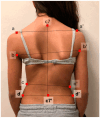Reliability of a New Digital Tool for Photographic Analysis in Quantifying Body Asymmetry in Scoliosis
- PMID: 38610880
- PMCID: PMC11012662
- DOI: 10.3390/jcm13072114
Reliability of a New Digital Tool for Photographic Analysis in Quantifying Body Asymmetry in Scoliosis
Abstract
Background: Advancements in non-ionizing methods for quantifying spinal deformities are crucial for assessing and monitoring scoliosis. In this study, we analyzed the observer variability of a newly developed digital tool for quantifying body asymmetry from clinical photographs. Methods: Prospective observational multicenter study. Initially, a digital tool was developed using image analysis software, calculating quantitative measures of body asymmetry. This tool was integrated into an online platform that exports data to a database. The tool calculated 10 parameters, including angles (shoulder height, axilla height, waist height, right and left waistline angles, and their difference) and surfaces of the left and right hemitrunks (shoulders, waists, pelvises, and total). Subsequently, an online training course on the tool was conducted for twelve observers not involved in its development (six research coordinators and six spine surgeons). Finally, 15 standardized back photographs of adolescent idiopathic scoliosis patients were selected from a multicenter image bank, representing various clinical scenarios (different age, gender, curve type, BMI, and pre- and postoperative images). The 12 observers measured the photographs at two different times with a three-week interval. For the second round, the images were randomly mixed. Inter- and intra-observer variabilities of the measurements were analyzed using intraclass correlation coefficients (ICCs), and reliability was measured by the standard error of measurement (SEM). Group comparisons were made using Student's t-test. Results: The mean inter-observer ICC for the ten measurements was 0.981, the mean intra-observer ICC was 0.937, and SEM was 0.3-1.3°. The parameter with the strongest inter- and intra-observer validity was the difference in waistline angles 0.994 and 0.974, respectively, while the highest variability was found with the waist height angle 0.963 and 0.845, respectively. No test-retest differences (p > 0.05) were observed between researchers (0.948 ± 0.04) and surgeons (0.925 ± 0.05). Conclusion: We developed a new digital tool integrated into an online platform demonstrating excellent reliability and inter- and intra-observer variabilities for quantifying body asymmetry in scoliosis patients from a simple clinical photograph. The method could be used for assessing and monitoring scoliosis and body asymmetry without radiation.
Keywords: body asymmetry; clinical photography; intraclass correlation coefficients; photogrammetry; reliability study; scoliosis assessment.
Conflict of interest statement
The sponsors had no role in the design, execution, interpretation, or writing of the study. The authors declare no financial or commercial conflicts of interest.
Figures


Similar articles
-
Validity and reliability of photographic measures to evaluate waistline asymmetry in idiopathic scoliosis.Eur Spine J. 2016 Oct;25(10):3170-3179. doi: 10.1007/s00586-016-4509-1. Epub 2016 Mar 14. Eur Spine J. 2016. PMID: 26975856
-
Reliability and validity study of measurements on digital photography to evaluate shoulder balance in idiopathic scoliosis.Scoliosis. 2014 Dec 14;9(1):23. doi: 10.1186/s13013-014-0023-6. eCollection 2014. Scoliosis. 2014. PMID: 25520746 Free PMC article.
-
Clinical photography in severe idiopathic scoliosis candidate for surgery: is it a useful tool to differentiate among Lenke patterns?Eur Spine J. 2019 Dec;28(12):3018-3025. doi: 10.1007/s00586-019-06096-w. Epub 2019 Aug 8. Eur Spine J. 2019. PMID: 31396690
-
Two-dimensional digital photography for child body posture evaluation: standardized technique, reliable parameters and normative data for age 7-10 years.Scoliosis Spinal Disord. 2017 Dec 19;12:38. doi: 10.1186/s13013-017-0146-7. eCollection 2017. Scoliosis Spinal Disord. 2017. PMID: 29276784 Free PMC article. Review.
-
Reliability and Validity of Scoliosis Measurements Obtained with Surface Topography Techniques: A Systematic Review.J Clin Med. 2022 Nov 26;11(23):6998. doi: 10.3390/jcm11236998. J Clin Med. 2022. PMID: 36498575 Free PMC article. Review.
Cited by
-
Responsiveness of trunk asymmetry measurements in clinical photographs after adolescent idiopathic scoliosis surgery.Eur Spine J. 2025 Jul;34(7):2781-2787. doi: 10.1007/s00586-025-08918-6. Epub 2025 May 15. Eur Spine J. 2025. PMID: 40372456
-
Improving Delphi Process in Acupuncture Decision Making: Overall Descriptions and Quality Assessment of Delphi Reports.J Multidiscip Healthc. 2024 Aug 30;17:4243-4256. doi: 10.2147/JMDH.S481947. eCollection 2024. J Multidiscip Healthc. 2024. PMID: 39228515 Free PMC article. Review.
References
Grants and funding
LinkOut - more resources
Full Text Sources

